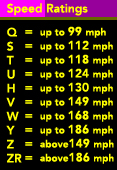
SHOP for TIRES
Information on Tire Markings
How to Read What's Printed on Tires
See all the Tire Sizes we carryMavis Tires & Brakes is committed to helping you learn whatever you may wish to know about your tires. For example, tires sold by Mavis and others contain a considerable amount of information that can help you select the ideal tires for your vehicle.
These markings, required of tire manufacturers, enable consumers to know for what vehicle type and under what conditions a tire is designed to perform properly.

Tire Type -- defines the proper use of the tire. "P" indicates this is a passenger tire or SUV tire. If the tire has an "LT" designation, it is meant for a Light Truck.
Tire Width -- an indication of the tire's width as measured in millimeters from sidewall to sidewall. In the sample above, the section width is 215 millimeters. The width of the tires is determined by need. For instance, wider tires are generally found on performance cars because they help hold the road around curves and turns at higher speeds.
Aspect Ratio -- the ratio of the height of the tire's cross-section to its width. In the sample above, 65 means that the height is equal to 65% of the tire's width. The significance of aspect ratio in today's market is that many customers prefer lower aspect ratios that provide quicker handling.
High-performance tires have a low aspect ratio, generally 70 or below. Although the tire is less flexible, it is able to quickly transmit input from the steering wheel to the tread. This translates into faster steering response, more precise cornering and easier performance handling.
Construction -- tells you how the tire was put together. The "R" stands for radial, which means that the body ply cord runs radially across the tire from bead to bead. A "B" indicates the tire is of bias construction, meaning the body ply cords run diagonally across the tire from bead to bead.
Rim Diameter -- the distance from one outside corner of the rim to the opposite side. The diameter in the example above is 15 inches.

Speed Rating -- an alphabetical designation indicating the top speed for which the tire has been certified. Speed ratings originated in Europe, where the lack of speed limits made certification necessary. Their function in the U.S. is to make sure the tires match the speed capabilities of the vehicle. Generally, it is recommended that a speed-rated tire be replaced with a tire having an equivalent or greater speed rating. In situations where tires having different top speed ratings are mixed on a vehicle, the maximum speed certification is limited to the top speed certification of the tire with the lowest speed rating.
Speed ratings do not indicate how well a tire handles or corners. They only certify a tire's ability to withstand high speed. You will find the speed rating designation at the end of the stamp: P225/65R15 95S or right after the aspect ratio: P255/50 ZR16. When load and speed symbols are used together, like 95S shown above, it is referred to as a service description.
 Load Index -- a number that corresponds to the maximum load (in pounds) that a tire can support when properly inflated. You will also find the maximum load (in Ibs & kg) molded elsewhere on the tire sidewall. The load that a tire is required to carry and the operating speed have a direct effect on the strength, tread life and cornering capabilities of the tire. These characteristics are so important that the U.S. Government Department of Transportation (D.O.T.) has made regulations to keep users informed of tire load. So, if you see a size that includes a number such as 105, you can verify the load carrying capabilities of the tire by checking the load index chart. This commonly will not be used or needed for most passenger cars. However, they should be used with pickups, SUVs or other light trucks. Always check the door placard and owner's manual for this information.
Load Index -- a number that corresponds to the maximum load (in pounds) that a tire can support when properly inflated. You will also find the maximum load (in Ibs & kg) molded elsewhere on the tire sidewall. The load that a tire is required to carry and the operating speed have a direct effect on the strength, tread life and cornering capabilities of the tire. These characteristics are so important that the U.S. Government Department of Transportation (D.O.T.) has made regulations to keep users informed of tire load. So, if you see a size that includes a number such as 105, you can verify the load carrying capabilities of the tire by checking the load index chart. This commonly will not be used or needed for most passenger cars. However, they should be used with pickups, SUVs or other light trucks. Always check the door placard and owner's manual for this information.
WARNING: Before you replace your tires, always consult the vehicle owner's manual and follow the vehicle manufacturer's replacement tire recommendations. If the vehicle owner's manual prohibits changing tire sizes, you must not change the size of the tire. Vehicle handling may be significantly affected by a change in tire size or type. When selecting tires that are different from the original equipment size, see a professional installer in order to make certain that proper clearance, load carrying capacity and inflation pressure is selected. Never exceed the maximum load capacity and inflation pressure listed on the sidewall of the tire. Always drive safely and obey all traffic laws. Avoid sudden, sharp turns or lane changes. Failure to follow this warning may result in loss of control of the vehicle, leading to an accident and serious injury or death.
Uniform Tire Quality Grading System (UTQG) mandated by the D.O.T. -- requires manufacturers to grade passenger car tires (excluding snow tires) based on three performance factors: treadwear, traction and temperature resistance.
Treadwear
- More Than 100 - Better
- 100- Baseline
- Less Than 100 - Poorer
The treadwear grade is a comparative rating based on the wear rate of the tire when tested under controlled conditions on a specified government test track. A tire graded 200 would wear twice as long on the government test track as one graded 100. Your actual tire mileage depends upon the conditions of their use and may vary due to driving habits, service practices, differences in road characteristics and climate.
Note: Treadwear grades are valid only for comparisons within a manufacturer's product line. They are not valid for comparisons between manufacturers.
Traction
- A - Best
- B - Intermediate
- C - Acceptable
The traction grade represents the tire's ability to stop on wet pavement as measured under controlled conditions on specified government test surfaces of asphalt and concrete. The traction grade is based upon "straight ahead" braking tests; it does not indicate cornering ability.
Temperature
- A - Best
- B - Intermediate
- C - Acceptable
The temperature grade represents the tire's resistance to the generation of heat when tested under controlled conditions on a specified indoor laboratory test wheel. Sustained high temperatures can cause the materials of the tire to degenerate and thus reduce tire life. Excessive temperatures can lead to tire failure. Federal law requires that all tires meet at least the minimal requirements of Grade C.
Any questions? Ask Mavis!
Mavis Tires & Brakes invites you to submit any tire-related question to us. A tire expert will answer your question as soon as possible.
